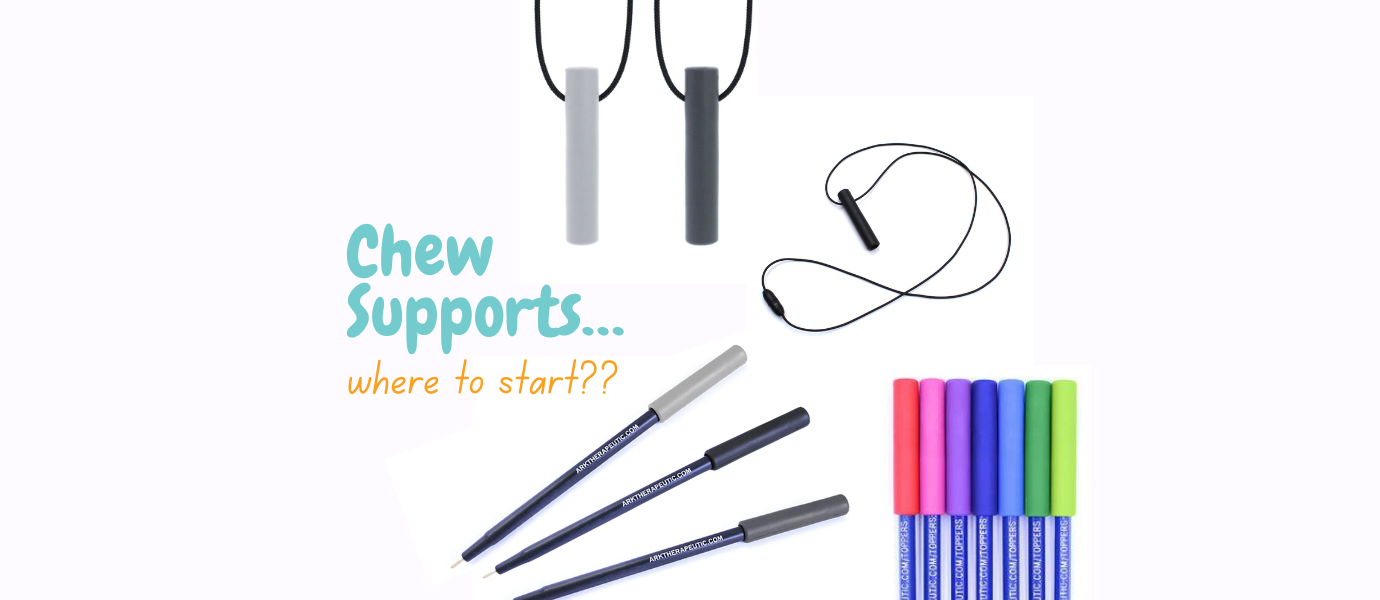
Chew Supports … where to start??
I get asked about chewing and supports frequently. So i thought I would share with you my tips and thoughts.
Understanding what is often behind the chewing can be helpful…. When trying to emotionally regulate/calm it is instinctive to be ‘oral’ . Our brain is wired to seek oral input to calm/regulate/stabilise… it’s why we often comfort eat, chew nails, fingers, tops, clothes, even ‘over’ talking can be based in this need! I’m sure it is a ‘story’ many of us are familiar with. Also, crunchy foods such as carrots, apples and things like chewing gum & chewy lollies are an instinctive ‘go to’ for many. These become an even more powerful tool when we understand why so that it may become a conscious tool we seek when needed.
It’s helpful to know that our core stabilisation starts in the mouth. Chewing is often a direct response to needing to stabilise core/decrease cortisol /adrenaline and brain’s way of trying to increase focus/regulate. Sensory tools (including chewing) do greatly assist with reducing anxiety for most. What actually happens in the brain is ..
When anxious or stressed
- our survival/instinctive part of brain SWITCHES ON (amygdala) & releases cortisol and adrenalin which SWITCHES OFF the front part of the brain (frontal cortex which is essentially responsible for executive function (learning, thinking , reason etc)
- ….. SO when we are anxious or stressed or under ‘threat’ ADRENALIN & CORTISOL are high = FLIGHT FIGHT ON / EXECUTIVE FUNCTION OFF
- MOVEMENT activates the part of the brain that DROPS ADRENALIN & CORTISOL - any movement does this which is why chewing & fidgeting are awesome, as are big movements such as tumbling, jumping, walking etc
- as ADRENALIN & CORTISOL lower, the executive function (front part) of brain can SWITCH BACK ON and allow concentration/function/learning/ listening etc
The jaw, being the closest moving joint to the brain, is the most ‘efficient’ body movement & why JAW MOVEMENT is often the brains ‘go to’ when anxious.
Of course, for some, chewing gum is not an option (texture, taste, additives etc etc) and that’s perfectly OK. Honestly, the KEY is the jaw movement or CHEW factor – so anything that allows a rigorous chew is a great alternative.
There are many brands of chew supports on the market. We exclusively stock the ARK range. We like that they are made in the USA with strict testing and safety information. We love that they are designed by a team of therapists. Chewing as a sensory support is something that for many continues into adulthood and is perfectly valid, so we highly rate the fact that they have a range suitable for teens and adults. Finally, my favourite part is that ARK come in a range of textures, thicknesses and strengths – Standard (softest), Medium (XT) and Firm/toughest (XXT).
“I want to try a chew support, where do I start?”
I typically like to explore what the person is using intuitively, as that will give important information about the shape or style of chew support to try. If putting items into the back of mouth and using molars is the ‘go to’ then something that is long in shape so that it reaches the same area is a helpful start. If, for example, chewing on skin, hands, straws, bottle tops I tend to suggest chew supports that allow ‘collapse’ on chew, such as the ARK hollow range.
I am chewing through my chew supports really quickly, any suggestions?”
I also think it is worth trying the hollow variety above for those that are ‘aggressive’ chewers and going through chews quickly. Counter intuitively, I find often when chews are getting destroyed it’s because the ‘mouth’ isn’t getting the right sort of oral feedback it needs i.e. it is seeking ‘collapse’ (similar to chewing on skin, cheek, straws, gum etc ) so it chews HARDER into the chews trying to achieve the collapse …but not getting it …so chewing even harder which results in its quick demise. This is not true for all but certainly worth considering.
The ARK pen and pencil toppers can also be used as a hollow chew support when taken off the pen/pencil. They make a terrific small in pocket size hollow chew.
“Which strength should I choose?”
This is so personal & depends on the style and degree of chewing. I tend to suggest starting with the middle (XT) strength, unless they are a ‘light chewer’ then the softest (standard) strength is usually the most tolerated. The ARK Chewth Pick (both the smooth and textured varieties on our website) actually have a packet of 3 strengths in one which is great for testing strengths if unsure. These are small chew supports so might not suit everyone.
“What style should I try?”
Again, so dependant on the individuals age, style of chewing and purpose of the chew support. There are wearables such as necklaces with breakaway clasps & wrist chews. Also, ARK have a handheld range and chew supports that are pen & pencil toppers. Often, it’s a combination of these that works well. Preference for shape (which impacts the experience in oral input) and texture (smooth or textured) also important to consider in selection.
It is helpful to understand that chew supports are consumables and do need replacement, sometimes regularly. Once you find the supports that work best, having duplicates as backups an excellent idea. If the chew is showing signs of wear/deterioration it’s time to replace. It is also important to regularly wash them. Warm soapy water works well.
I hope this helps in you embracing the benefits of chew supports, whether it be crunchy foods, chewing gum or tools such as the ARK range.
JO